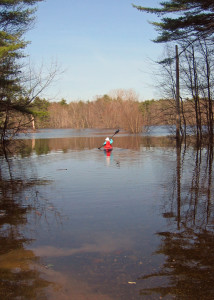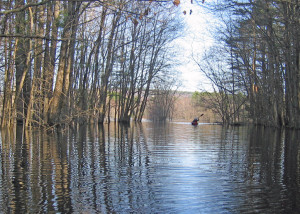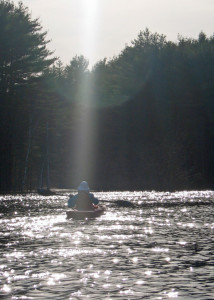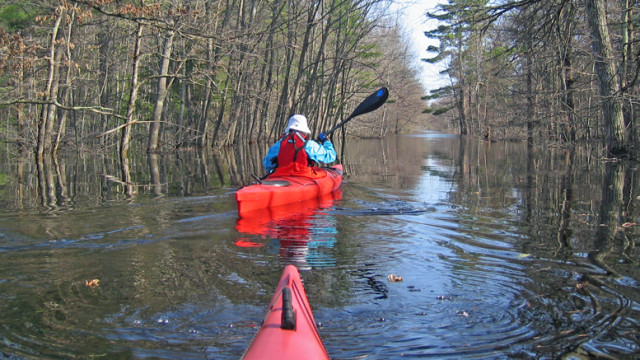
Try Something Different: Kayaking on Flooded Roads!
The country lane my sweetheart, Marilyn normally takes to get to work is called “River Road,” and it indeed follows a river, right through a mile or so of land controlled by the U.S. Army Corps of Engineers. Which means that, whenever we get really heavy rains, the road gets closed and she has to take an alternate route to work. Lately, she’s been taking her alternate route a lot.
The recent flooding rains that hit much of the northeast (that seems to be happening more often in recent years) put her normal route under about 10 or 12 feet of water. That fact, plus an absolutely gorgeous warm, sunny Saturday in early April gave us a unique and wonderful excuse to get the kayaks out and go kayaking on flooded roads at a time of year when we’d normally still be heading to the mountains for one last ski adventure.
Even in my world, where almost anything can serve as an excuse for an Active Outdoors adventure, carrying our kayaks the hundred yards from the gate that closed the road to the edge of the flood and then launching them to paddle on a road we normally drive nearly every day seemed a bit unusual. Marvelous even. Adventures happen wherever you find them.
There’s definitely a “Toto, I’ve a feeling we’re not in Kansas anymore,” sensation to paddling on deep water over what would normally be dry land. Where the road passed between the river bank and a large cornfield, there was now a substantial pond with flooded trees surrounding it. There was no hint of the rolling contours for the field, just a flat expanse of wind-riffled water. Only the bordering tree tops served to define the course of the road and the edge of the field. Branches which normally arc at box-truck height above the road had become obstacles we had to paddle around. Ten-foot high bushes that normally would have kept us on the road were nowhere to be seen. What is normally a flowing brook passing beneath a small bridge was, on this day, just another spot on the placid pond. It was truly magic in an “over the rainbow” way.

When the flood control dam was built, the old highway which passeg through this flood-control land was re-routed onto higher ground. The old roadbed is still there and we were able to follow it more than a mile in one direction, detouring through a marsh (now a pond) where we often listen to spring peepers. Logging roads through the trees were largely impassable – too many tangled branches at head level, too many floating logs . . .
Before heading back to the car, we paddled out onto what would normally be a river with rocky rapids. Not on this day. Again, it was a placid and beautiful pond surrounded by flooded timber.
An uncontrolled flood is a terrible thing as it indiscriminately destroys the landscape created by both man and nature. But contained safely behind a dam and allowed to flow away harmlessly at a carefully-controlled rate, this flood became a thing of beauty, a chance to get outdoors, have fun and savor a different look at a place we thought we knew well.
Play It Safe: Cold Water Paddling Safety When Kayaking On Flooded Roads

Unseasonably warm weather in April gets people thinking about summer—sometimes too soon for their own good. I’ve seen a number of reports in recent days of hikers, canoeists and kayakers here in the northeast needing to be rescued. Those are the lucky ones. For some, the effort has been made to find and recover their bodies . . .
On the warm day we went paddling, the water was still extremely cold, which creates an unsafe situation. If you dress for protection from the cold water, you’re going to overheat while paddling in the warm sun. We wore paddling dry suits with light fleece under, plus, of course, our paddling PFDs. And, we stayed close to each other so we could help out if something went wrong. Marilyn isn’t a strong swimmer, but her kayak is an extremely stable 14-foot Perception Carolina, so a spill into the cold water was unlikely . . . But still. Hypothermia sets in quickly when the water is still just a few degrees above freezing. Better safe than sorry.


